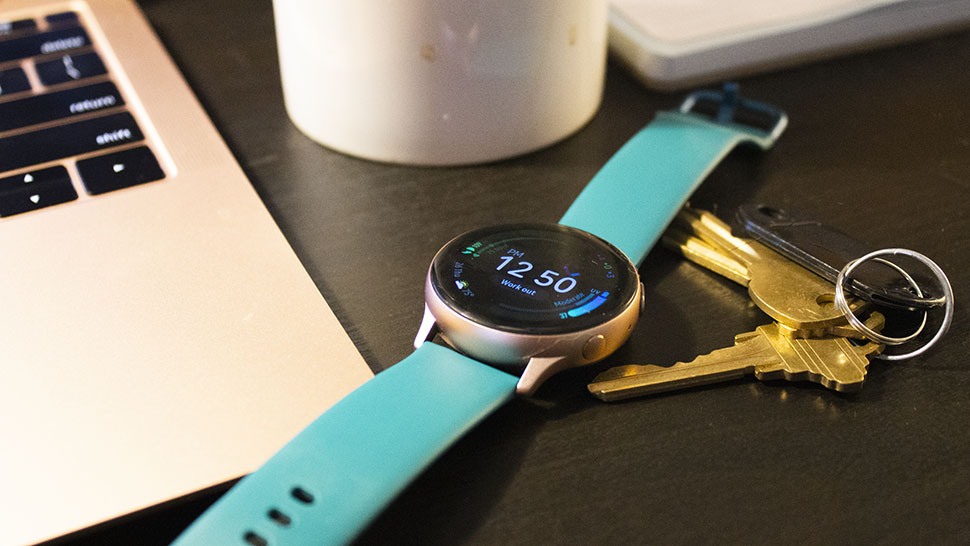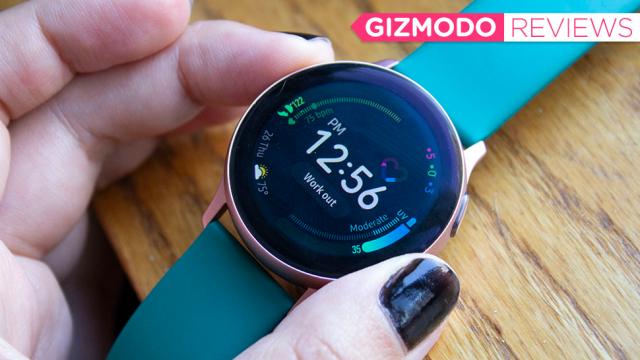When I unboxed the Samsung Galaxy Watch Active2 last week, I was rooting for it. On paper, the Active2 had a lot going for it. It’s a good looking watch with solid app offerings and multi-day battery life. It’s reasonably priced, and now comes with LTE connectivity. There was just one thing potentially standing in its way: Health tracking.

Samsung Galaxy Watch Active2
What is it?
Samsung's mid-tier smartwatch
Price
$549 for the 44mm.
Like
Looks great. MyStyle is fun. Fixed heart rate monitoring issues. Good battery life. A dang-near perfect smartwatch.
No Like
The step and GPS distance tracking is laughably bad.
Editor’s Note: Australian isn’t receiving the 40mm variant of the watch, and its ECG functionality will likely be inactive due to local health regulation.
The original Active was godawful at health tracking. The heart rate sensors were wonky and I couldn’t get consistent readings across multiple features. The step tracking was also egregiously off — in testing it underreported steps compared to a control pedometer by nearly 20 per cent.
With the Active2, Samsung said it’d fixed these issues with eight heart rate sensors and a better accelerometer. Big, if true. While plenty of people buy smartwatches as a sort of mini smartphone, health and wellness tracking is also a major draw. Samsung has had some good ideas on this front, but was always kneecapped by accuracy.
After a week of testing, I find Samsung’s claim that it’s fixed its health-tracking problems is half true. The new heart rate sensors work reliably and consistently. With regard to accuracy, the heart rate monitoring is on par with other smartwatches and fitness trackers I’ve tested. The step and GPS tracking, however, leave much to be desired.
I wore both the Active2 and Apple Watch Series 5 for a long day of walking around Little Italy, Tribeca, and the East and West Village in New York City. Both watches were worn for the same amount of time, from the moment I woke up to the second my head hit the pillow. The Apple Watch recorded 18,322 steps, 13km, and 636 active calories burned. The Active2 gave me 29,934 steps, 21km walked, and 1032 calories burned.
A gap of over 11,000 steps and roughly 10km is plain terrible, and given how recent smartwatches have trended toward higher accuracy, I was shocked. To triple check, I retraced my path on Google Maps. As much as I would love to give myself credit for walking 21km in a day, the truth is it was much closer to 8km. 21km is also slightly less than the length of Manhattan.
I did not walk anything close to that on that day. On the off-chance this was a one-time fluke, I wore both watches for the same period of time the next day. The Series 5 logged 12,996 steps, 10km, and 559 active calories. The Active2 logged 21,222 steps, 16km, and 779 calories. Still bad.
That also extended to GPS distance tracking. Using the MapMyRun app on my phone, I recorded an easy 30-minute, 3km run at an average pace of 12’23” per kilometre. The Active2 logged this as 5km, at an average pace of 10’47” per kilometre. The Series 5 logged it as 3km and an average pace of 12’22” per kilometre. It might seem stupid to quibble over 0.56 kilometres but that sort of thing matters when you’re training for any type of race and at longer distances, this sort of inaccuracy tends to snowball. Also, shaving over a minute off your mile splits is a pretty big achievement for amateur and pro runners alike. Again, I love the credit Samsung, but that day I did not earn it.
Discrepancies between different smartwatches is to be expected as companies all use their own proprietary software to interpret data from sensors. Wild gaps used to be more common, but nowadays anything over 1,000 steps and a half-mile could be a sign a company may not be accurately filtering for random arm movements.
For reference, I frequently wear an Apple Watch and Fitbit Versa simultaneously in my downtime just to compare stats. On a recent trawl through Berlin, the Apple Watch Series 4 logged 21,520 steps and 14km. The Fitbit Versa 2 logged 22,687 steps and 14km. This is the sort of gap you’d expect from two accurate, but algorithmically different devices. The gap I got between the Series 5 and Active2 was more of a red flag that something’s not quite right.
I checked in with some other reviewers who I also knew were testing the Active2 — and it seems I’m not the only one who experienced some inconsistent results, though none were quite as pronounced as mine. That could be a combination of me being someone who gesticulates a lot, or just longer test runs and distances.
As I mentioned, small inaccuracies over a short distance have a tendency to become gigantic ones over long distances. I reached out to Samsung and in our back-and-forths, it doesn’t appear I have a busted device. For its part, Samsung told me the device is “more focused on accountability, and using the data to inform users’ decision making so they can reach their goals.” Basically, Samsung’s happy if you’re using the watch and as a result, you become more active.
This is disappointing because yet again, I love everything else about the Active2. The touch bezel navigation is a joy to use, and a natural progression from the signature rotating bezel of its older watches. The 1.2-inch AMOLED screen is bright and easy to read. Tizen OS is snappier than Wear OS. I find the interface to be more intuitive than WatchOS’s scattered app layout. The face is round, for all the square smartwatch haters, and there’s loads more third-party watch faces to choose from than with Apple.
Every time I review a new Samsung watch, there’s also more app options than before. With the Active2, you can now watch YouTube videos from your wrist. Why you would want to, I don’t know but you can. (I watched part of Bon Appetit’s Gourmet Makes, Hot Pocket episode. It was laggy but it worked.) You can also tweet from your wrist. You have Samsung Pay for NFC payments, and there’s Bixby as a voice assistant. (Bixby is not good but it’s honestly not that much worse than Siri at simple tasks like setting timers.)
The MyStyle watch faces were also a neat addition. Right now it’s limited to Android-users only, but within the Samsung Wearable app, you can fire up your phone’s camera, snap a picture of your outfit, and it’ll generate a few custom faces based on what colours you’re wearing. I personally prefer a watch face with more complications, but it’s fun for fancier occasions, like a wedding or a special date night.
Battery life on the Active2 is also solid. With moderate use, I got about three days on a single charge. Not as good as a Fitbit, but much better than the Series 5 — long enough to reliably track your sleep without worrying the watch will die on you. Obviously, this will depend on your individual usage and whether you opt for the LTE version, or how frequently you use battery-guzzling apps and features.
All these things are legitimately good. If Samsung had fixed its health-tracking software, they would’ve been great. Even the watch’s other health features would’ve been killer if I could trust the accuracy. Samsung’s automatic activity recognition is solid and saves you the trouble of manually logging walks and runs; it’s just I can’t really trust the stats it logs.
With the Active2, Samsung introduced a new Running Coach feature and I desperately wanted to like it too. Keeping a consistent pace is one of the hardest things about running outside, and the idea of a wrist-based coach telling me when to slow down and speed up to maintain a good pace is genuinely great. In practice, I found the Running Coach frustrating because it seemed to think I was running faster than I was. It kept buzzing, telling me to slow down. If I’d run any slower, I’d have been speed-walking.
You can work around the health inaccuracies by routinely rounding down in workouts and knocking a few thousand steps off your all-day counts. Or, if you’re training for a specific distance, I’d recommend hitting the treadmill, tracking via a phone app, or pre-planning a route via Google Maps. It’s just these devices are supposed to make your life easier, not give you more work — especially if you’ve got a health goal you’re working toward.
To be completely fair, not everyone views health tracking as a priority when buying a smartwatch. For those folks, the Samsung Galaxy Watch Active2 ticks off nearly every box. This is especially true for Android users — even with my accuracy rant, the Galaxy Watch Active2 and Samsung’s more premium Galaxy Watch are two of your best options.
It’s even good for iPhone users who aren’t keen on the Apple Watch for one reason or another. (The only downside is iPhone users don’t get the MyStyle option). And at $549 for the slightly bigger 44mm, it’s affordable for a smartwatch.
Personally, I’d have gleefully traded the YouTube and Twitter capabilities, the MyStyle options, and the Running Coach for a more accurate Active2. Those weren’t the things the watch needed to be truly great. I’d have happily waited more than six months for better health tracking. For now, I can only cross my fingers that the next update will finally get it right.
README
-
Beautiful, nearly perfect smartwatch.
-
The main issue is Samsung still hasn’t fully fixed its health-tracking software. Heart rate monitoring is better, steps and GPS distance still awful.
-
New additions include customisable MyStyle watch faces (Android only), YouTube and Twitter, a Running coach, LTE capability, eight photodiode heart rate sensors and better accelerometer.
-
Battery life was about 2-3 days in testing.
-
Reasonably priced.
